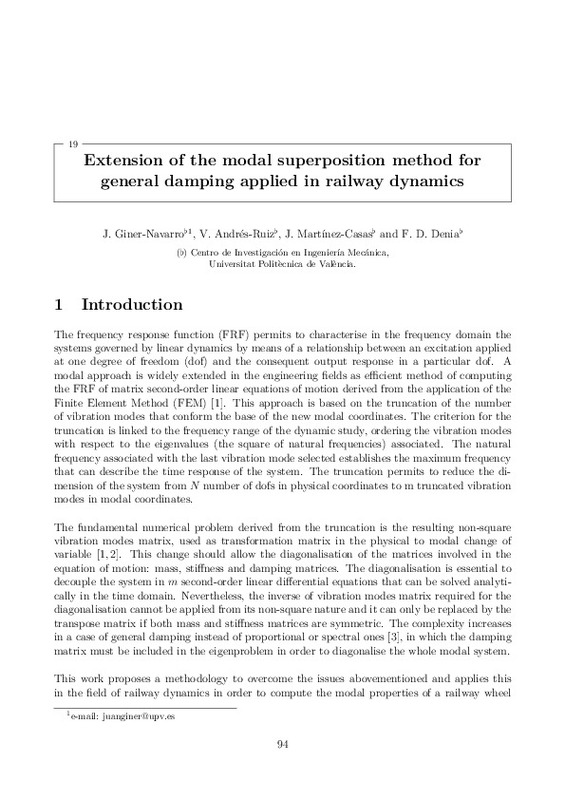JavaScript is disabled for your browser. Some features of this site may not work without it.
Buscar en RiuNet
Listar
Mi cuenta
Estadísticas
Ayuda RiuNet
Admin. UPV
Extension of the modal superposition method for general damping applied in railway dynamics
Mostrar el registro sencillo del ítem
Ficheros en el ítem
| dc.contributor.author | Giner Navarro, Juan
|
es_ES |
| dc.contributor.author | Andrés-Ruiz, Víctor Tomás
|
es_ES |
| dc.contributor.author | Martínez Casas, José
|
es_ES |
| dc.contributor.author | Denia Guzmán, Francisco David
|
es_ES |
| dc.date.accessioned | 2022-02-07T08:29:18Z | |
| dc.date.available | 2022-02-07T08:29:18Z | |
| dc.date.issued | 2019-07-12 | es_ES |
| dc.identifier.isbn | 978-84-09-16428-8 | es_ES |
| dc.identifier.uri | http://hdl.handle.net/10251/180563 | |
| dc.description.abstract | [EN] The frequency response function (FRF) permits to characterise in the frequency domain the systems governed by linear dynamics by means of a relationship between an excitation applied at one degree of freedom (dof) and the consequent output response in a particular dof. A modal approach is widely extended in the engineering fields as efficient method of computing the FRF of matrix second-order linear equations of motion derived from the application of the Finite Element Method (FEM) [1]. This approach is based on the truncation of the number of vibration modes that conform the base of the new modal coordinates. The criterion for the truncation is linked to the frequency range of the dynamic study, ordering the vibration modes with respect to the eigenvalues (the square of natural frequencies) associated. The natural frequency associated with the last vibration mode selected establishes the maximum frequency that can describe the time response of the system. The truncation permits to reduce the dimension of the system from N number of dofs in physical coordinates to m truncated vibration modes in modal coordinates. The fundamental numerical problem derived from the truncation is the resulting non-square vibration modes matrix, used as transformation matrix in the physical to modal change of variable [1,2]. This change should allow the diagonalisation of the matrices involved in the equation of motion: mass, stiffness and damping matrices. The diagonalisation is essential to decouple the system in m second-order linear differential equations that can be solved analytically in the time domain. Nevertheless, the inverse of vibration modes matrix required for the diagonalisation cannot be applied from its non-square nature and it can only be replaced by the transpose matrix if both mass and stiffness matrices are symmetric. The complexity increases in a case of general damping instead of proportional or spectral ones [3], in which the damping matrix must be included in the eigenproblem in order to diagonalise the whole modal system. This work proposes a methodology to overcome the issues abovementioned and applies this in the field of railway dynamics in order to compute the modal properties of a railway wheel modelled by using FEM [4]. The paper includes a study of the numerical performance of this method and its comparison with other numerical procedures to find the FRF of the wheel. | es_ES |
| dc.description.sponsorship | The authors gratefully acknowledge the financial support of FEDER/Ministerio de Ciencia, Innovacion y Universidades Agencia Estatal de Investigacion (project TRA2017-84701-R), as well as Conselleria d¿Educacio, Investigacio, Cultura i Esport (project Prometeo/2016/007) and European Commission through the project RUN2Rail - Innovative RUNning gear soluTiOns for new dependable, sustainable, intelligent and comfortable RAIL vehicles (Horizon 2020 Shift2Rail JU call 2017, grant number 777564). | es_ES |
| dc.language | Inglés | es_ES |
| dc.publisher | R. Company, J. C. Cortés, L. Jódar and E. López-Navarro | es_ES |
| dc.relation.ispartof | Modelling for Engineering & Human Behaviour 2019 | es_ES |
| dc.rights | Reserva de todos los derechos | es_ES |
| dc.subject.classification | INGENIERIA MECANICA | es_ES |
| dc.title | Extension of the modal superposition method for general damping applied in railway dynamics | es_ES |
| dc.type | Comunicación en congreso | es_ES |
| dc.type | Capítulo de libro | es_ES |
| dc.relation.projectID | info:eu-repo/grantAgreement/AEI/Plan Estatal de Investigación Científica y Técnica y de Innovación 2013-2016/TRA2017-84701-R/ES/DESARROLLO DE UN MODELO INTEGRAL DE INTERACCION VEHICULO%2FVIA EN CURVA PARA LA REDUCCION DEL IMPACTO ACUSTICO DEL TRANSPORTE FERROVIARIO/ | es_ES |
| dc.relation.projectID | info:eu-repo/grantAgreement/GVA//PROMETEO%2F2016%2F007//Modelado numérico avanzado en ingeniería mecánica/ | es_ES |
| dc.relation.projectID | info:eu-repo/grantAgreement/EC/H2020/777564/EU/ | es_ES |
| dc.rights.accessRights | Abierto | es_ES |
| dc.contributor.affiliation | Universitat Politècnica de València. Departamento de Ingeniería Mecánica y de Materiales - Departament d'Enginyeria Mecànica i de Materials | es_ES |
| dc.description.bibliographicCitation | Giner Navarro, J.; Andrés-Ruiz, VT.; Martínez Casas, J.; Denia Guzmán, FD. (2019). Extension of the modal superposition method for general damping applied in railway dynamics. R. Company, J. C. Cortés, L. Jódar and E. López-Navarro. 94-98. http://hdl.handle.net/10251/180563 | es_ES |
| dc.description.accrualMethod | S | es_ES |
| dc.relation.conferencename | Mathematical Modelling in Engineering & Human Behaviour 2019 | es_ES |
| dc.relation.conferencedate | Julio 10-12,2019 | es_ES |
| dc.relation.conferenceplace | Valencia, Spain | es_ES |
| dc.relation.publisherversion | https://imm.webs.upv.es/jornadas/2021/past_editions.html | es_ES |
| dc.description.upvformatpinicio | 94 | es_ES |
| dc.description.upvformatpfin | 98 | es_ES |
| dc.type.version | info:eu-repo/semantics/publishedVersion | es_ES |
| dc.relation.pasarela | S\391643 | es_ES |
| dc.contributor.funder | Generalitat Valenciana | es_ES |
| dc.contributor.funder | SHIFT2RAIL JOINT UNDERTAKING | es_ES |
| dc.contributor.funder | AGENCIA ESTATAL DE INVESTIGACION | es_ES |
| dc.contributor.funder | European Regional Development Fund | es_ES |






